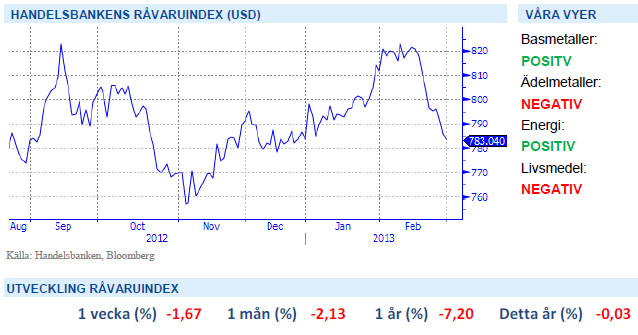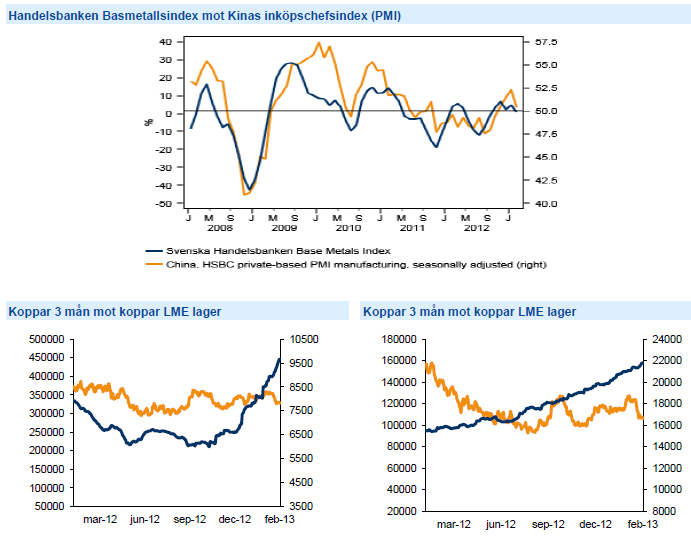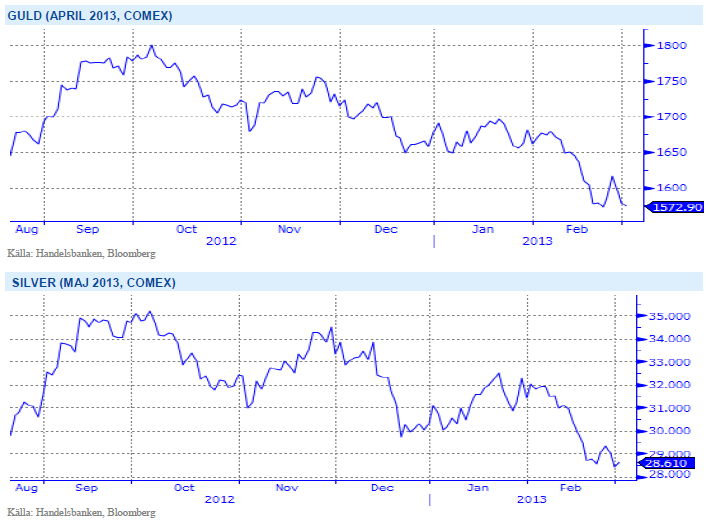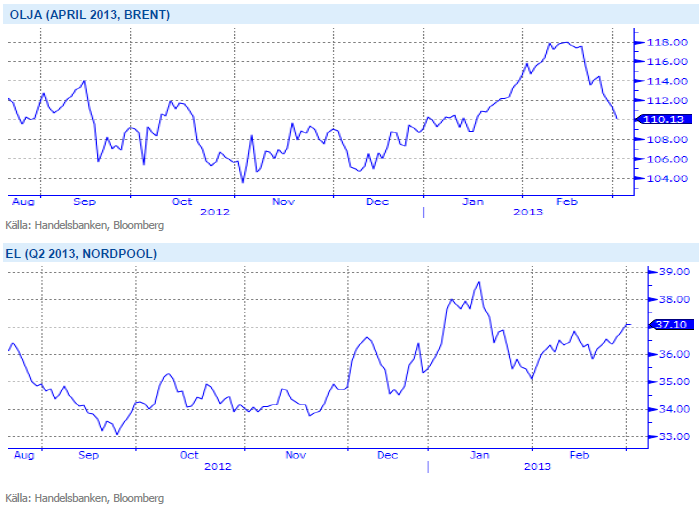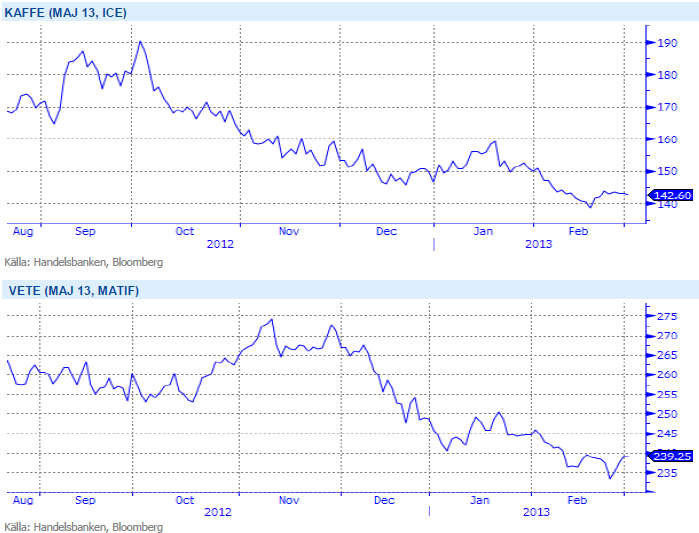Analys
SHB Råvarubrevet 1 mars 2013

 Råvaror allmänt
Råvaror allmänt
Ytterligare svag vecka för råvarorna
Dödläget efter italienska valet tillsammans oron över kommande finanspolitiska åtstramningar i USA utöver en svagare aktiemarknad har lett råvarorna nedåt under ytterligare en svag vecka. Värst drabbad var åter nickel som nu tappat 11 % från sin högsta notering under februari. Även om vissa datautfall som inköpschefsindex för EMU-området och Kina varit något sämre än väntat har dataskörden överlag varit fortsatt god. För Kina sjönk PMI för februari till 50,1 från januari 50,4 (väntat var 50,5).
Som vanligt är data från Kina svårtolkad under första kvartalet då effekterna av ledigheten efter det kinesiska nyåret ibland infaller i januari och ibland i februari. Årets börsrally har fortsatt att sätta positivt avtryck i företagens och hushållens stämningsläge, skattehöjningar och nedskärningar till trots. Den bild vi har av makroutvecklingen ger stöd för uppgång för konjunkturhandlade råvaror. I USA handlar det om att hushållen svarar mot den förbättring som äger rum på bostadsmarknaden. Skattehöjningar, nedskärningar och kanske även en minskning av federala utgifter i slutet av april utgör motvindar. Detta har dock hittills motverkats av positiva förmögenhets- och sentimentseffekter.
Vi återgår även till negativ vy för livsmedel, trots risk för fortsatt torka i USA tror vi att dagens nivåer på spannmål är alltjämnt för höga.
Basmetaller
Metallernas fall fortsätter
Basmetallerna lägger ytterligare en vecka bakom sig med fallande priser. Ett sämre PMI än väntat från Kina ger metallerna fortsatt skjuts nedåt under fredagen. Nickel föll under veckan med 3 % och koppar med 2,2 %. Stigande lager på både koppar (+7 % under veckan) och nickel (+2,8 % under veckan) ger också stöd åt bilden.
Basmetallerna har svajat omkring bland sina tekniska handelsintervall styrda av de olika glidande medelvärdena. Vi tycker att nedgången i basmetaller är driven av kortsiktig besvikelse och har väldigt lite med realekonomin att göra. Därför ser vi de svaga basmetallerna som köpvärda. Vi fortsätter hålla nickel och koppar som de bästa alternativen för att kapitalisera på ett starkare Kina.
Trots nedgången senaste veckorna tror vi på högre priser på basmetaller och ser istället möjlighet till ”buy on dip”. Vi tror på: BASMET H
Ädelmetaller
Dödskors för guld
Under förra veckan inträffade vad som bland tekniska analytiker brukar kallas ett dödskors. Det korta glidande medelvärdet på 50 dagar skär då ner igenom det långa glidande medelvärdet på 200 dagar. Det brukar ofta signalera ett trendskifte nedåt för en marknad. Det omvända kallas guldkors och signalerar ett köpläge för en marknad som bryter uppåt. För guld var detta dödskors det fjärde på sex år och nu väntar investerare med andan i halsen på utvecklingen denna gång. Även om guldraset summerar till över 5 % i februari tror vi att resan nedåt bara har börjat.
Guldet handlas svagt ned under veckan trots en stark början med en uppgång på 2,3 % som en respons på oron efter italienska valet och Bernankes tal i tisdags kväll som minskade oron för att QE3 kommer tas bort tidigare än väntat. Starkare dollar och högre räntor blir utmanande för guldet samtidigt som inflationen väntas vara låg under året. Vi behåller vår negativa vy för ädelmetallerna.
Starkare dollar och högre räntor blir utmanande för guldet samtidigt som inflationen väntas vara låg under året. Vi tror på: GULD S H
Energi
Iran i samtal om atomprogram
Oljan har också haft en tuff vecka där vi har fått se brent-oljan tillbaka på 110- nivån efter att legat om-kring 118 dollar under de två tidigare veckorna. Vi tycker att det är köpläge i råolja men såklart finns en hög risk på grund av senaste tidens oro på marknaderna. P5+1 (USA, U.K., Frankrike, Tyskland, Kina och Ryssland) träffade under veckan Iran i Almaty, Kazakhstan för att diskutera Irans atomprogram. Inga detaljer har släppts efter mötet där maktnationerna vill begränsa Irans atomprogram i utbyte mot att ta bort sanktionerna mot Irans oljeexport. Israel har hotat att bomba Irans atomenheter ifall samtalen inte leder till resultat. Nya möten ska upptas i mars.
En stilla elmarknad där kvartalskontraktet handlas upp någon procent till månadshögsta 37 euro som ett resultat av en något torrare väderutveckling. Energi-balansen oförändrad på ca -10 TWh och brytpriset på kol kvar strax under 36 euro för Q2 2013 efter att både kol och CO2 återhämtat sig något. Utsläppsrätterna föll 17 procent efter nytt besked om att flytta fram beslutet kring en förskjuten tilldelning. Samtidigt signalerar Tyskland att man står bakom en reform av EU ETS och eventuell backloading vilket bidrog till en återhämtning eftersom Tyskland med sin tyngd sannolikt kan komma att påverka att förslagen går igenom. Vi förväntar oss att rätterna handlas kvar på nuvarande nivå kring 5 euro.
Den råvarugrupp som är mest beroende av den globala konjunkturen är Energi och med en starkare konjunktur ser vi positivt på utvecklingen för denna sektor. Vi tror på: ENERGI H
Livsmedel
Kaffepriset får stöd
Under senare delen av februari har vi sett starka kaffepriser. De colombianska kaffeodlarna har pressat upp priserna efter ovilja att sälja på den senaste tidens låga nivåer. Även uteblivet regn i centrala Vietnam har gett stöd i veckan. De låga vattennivåerna ökar risken för minskad skörd nästa säsong. Skörden i Centralamerika är så gott som färdig med 20 procent av årets skörd beräknas vara skadat. Export från Indonesien, som världens tredje största Robusta producent, beräknas minska i takt med ökad inhemsk konsumtion, trots rekordskördar i området. Vi tror att marknaden prisat in dessa nyheter redan och anser att fortsatt uppsida är begränsad.
Under senaste veckan har vi kunnat notera stigande vetepriser som en följd av fortsatt torka i de amerikanska vetefälten men även i EU-området väntas regnet utebli. Med förväntat höga amerikanska majs-skördar, dagens historiskt höga vetepriser och än så länge inga dramatiska väderförändringar så ändrar vi vår vy från neutral till negativ på livsmedel och tror på fallande vetepriser.
Vi återgår till negative syn för soja, majs och vete, trots riskerna för torrt väder i USA. Normal väderlek bör ge press på spannmålspriserna. Vi tror på: LIVSMEDEL S H
Handelsbankens Råvaruindex
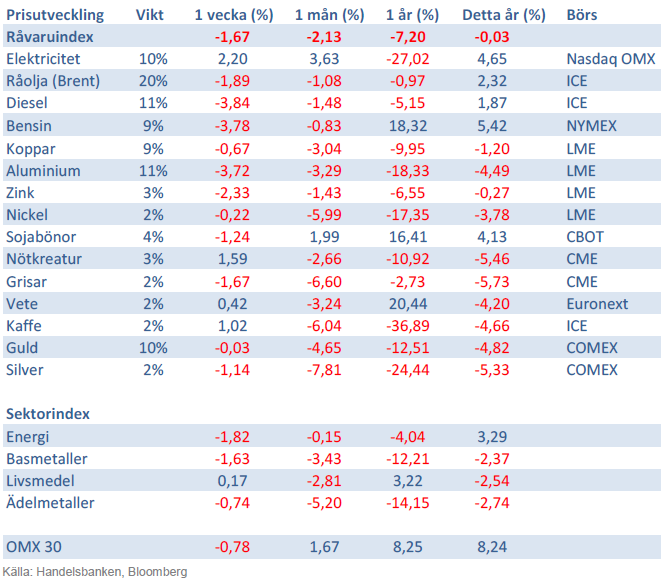
Handelsbankens råvaruindex består av de underliggande indexen för respektive råvara. Vikterna är bestämda till hälften från värdet av nordisk produktion (globala produktionen för sektorindex) och till hälften från likviditeten i terminskontrakten.
[box]SHB Råvarubrevet är producerat av Handelsbanken och publiceras i samarbete och med tillstånd på Råvarumarknaden.se[/box]
Ansvarsbegränsning
Detta material är producerat av Svenska Handelsbanken AB (publ) i fortsättningen kallad Handelsbanken. De som arbetar med innehållet är inte analytiker och materialet är inte oberoende investeringsanalys. Innehållet är uteslutande avsett för kunder i Sverige. Syftet är att ge en allmän information till Handelsbankens kunder och utgör inte ett personligt investeringsråd eller en personlig rekommendation. Informationen ska inte ensamt utgöra underlag för investeringsbeslut. Kunder bör inhämta råd från sina rådgivare och basera sina investeringsbeslut utifrån egen erfarenhet.
Informationen i materialet kan ändras och också avvika från de åsikter som uttrycks i oberoende investeringsanalyser från Handelsbanken. Informationen grundar sig på allmänt tillgänglig information och är hämtad från källor som bedöms som tillförlitliga, men riktigheten kan inte garanteras och informationen kan vara ofullständig eller nedkortad. Ingen del av förslaget får reproduceras eller distribueras till någon annan person utan att Handelsbanken dessförinnan lämnat sitt skriftliga medgivande. Handelsbanken ansvarar inte för att materialet används på ett sätt som strider mot förbudet mot vidarebefordran eller offentliggörs i strid med bankens regler.
Analys
Tightening fundamentals – bullish inventories from DOE

The latest weekly report from the US DOE showed a substantial drawdown across key petroleum categories, adding more upside potential to the fundamental picture.

Commercial crude inventories (excl. SPR) fell by 5.8 million barrels, bringing total inventories down to 415.1 million barrels. Now sitting 11% below the five-year seasonal norm and placed in the lowest 2015-2022 range (see picture below).
Product inventories also tightened further last week. Gasoline inventories declined by 2.1 million barrels, with reductions seen in both finished gasoline and blending components. Current gasoline levels are about 3% below the five-year average for this time of year.
Among products, the most notable move came in diesel, where inventories dropped by almost 4.1 million barrels, deepening the deficit to around 20% below seasonal norms – continuing to underscore the persistent supply tightness in diesel markets.
The only area of inventory growth was in propane/propylene, which posted a significant 5.1-million-barrel build and now stands 9% above the five-year average.
Total commercial petroleum inventories (crude plus refined products) declined by 4.2 million barrels on the week, reinforcing the overall tightening of US crude and products.


Analys
Bombs to ”ceasefire” in hours – Brent below $70

A classic case of “buy the rumor, sell the news” played out in oil markets, as Brent crude has dropped sharply – down nearly USD 10 per barrel since yesterday evening – following Iran’s retaliatory strike on a U.S. air base in Qatar. The immediate reaction was: “That was it?” The strike followed a carefully calibrated, non-escalatory playbook, avoiding direct threats to energy infrastructure or disruption of shipping through the Strait of Hormuz – thus calming worst-case fears.

After Monday morning’s sharp spike to USD 81.4 per barrel, triggered by the U.S. bombing of Iranian nuclear facilities, oil prices drifted sideways in anticipation of a potential Iranian response. That response came with advance warning and caused limited physical damage. Early this morning, both the U.S. President and Iranian state media announced a ceasefire, effectively placing a lid on the immediate conflict risk – at least for now.
As a result, Brent crude has now fallen by a total of USD 12 from Monday’s peak, currently trading around USD 69 per barrel.
Looking beyond geopolitics, the market will now shift its focus to the upcoming OPEC+ meeting in early July. Saudi Arabia’s decision to increase output earlier this year – despite falling prices – has drawn renewed attention considering recent developments. Some suggest this was a response to U.S. pressure to offset potential Iranian supply losses.
However, consensus is that the move was driven more by internal OPEC+ dynamics. After years of curbing production to support prices, Riyadh had grown frustrated with quota-busting by several members (notably Kazakhstan). With Saudi Arabia cutting up to 2 million barrels per day – roughly 2% of global supply – returns were diminishing, and the risk of losing market share was rising. The production increase is widely seen as an effort to reassert leadership and restore discipline within the group.
That said, the FT recently stated that, the Saudis remain wary of past missteps. In 2018, Riyadh ramped up output at Trump’s request ahead of Iran sanctions, only to see prices collapse when the U.S. granted broad waivers – triggering oversupply. Officials have reportedly made it clear they don’t intend to repeat that mistake.
The recent visit by President Trump to Saudi Arabia, which included agreements on AI, defense, and nuclear cooperation, suggests a broader strategic alignment. This has fueled speculation about a quiet “pump-for-politics” deal behind recent production moves.
Looking ahead, oil prices have now retraced the entire rally sparked by the June 13 Israel–Iran escalation. This retreat provides more political and policy space for both the U.S. and Saudi Arabia. Specifically, it makes it easier for Riyadh to scale back its three recent production hikes of 411,000 barrels each, potentially returning to more moderate increases of 137,000 barrels for August and September.
In short: with no major loss of Iranian supply to the market, OPEC+ – led by Saudi Arabia – no longer needs to compensate for a disruption that hasn’t materialized, especially not to please the U.S. at the cost of its own market strategy. As the Saudis themselves have signaled, they are unlikely to repeat previous mistakes.
Conclusion: With Brent now in the high USD 60s, buying oil looks fundamentally justified. The geopolitical premium has deflated, but tensions between Israel and Iran remain unresolved – and the risk of missteps and renewed escalation still lingers. In fact, even this morning, reports have emerged of renewed missile fire despite the declared “truce.” The path forward may be calmer – but it is far from stable.
Analys
A muted price reaction. Market looks relaxed, but it is still on edge waiting for what Iran will do

Brent crossed the 80-line this morning but quickly fell back assigning limited probability for Iran choosing to close the Strait of Hormuz. Brent traded in a range of USD 70.56 – 79.04/b last week as the market fluctuated between ”Iran wants a deal” and ”US is about to attack Iran”. At the end of the week though, Donald Trump managed to convince markets (and probably also Iran) that he would make a decision within two weeks. I.e. no imminent attack. Previously when when he has talked about ”making a decision within two weeks” he has often ended up doing nothing in the end. The oil market relaxed as a result and the week ended at USD 77.01/b which is just USD 6/b above the year to date average of USD 71/b.

Brent jumped to USD 81.4/b this morning, the highest since mid-January, but then quickly fell back to a current price of USD 78.2/b which is only up 1.5% versus the close on Friday. As such the market is pricing a fairly low probability that Iran will actually close the Strait of Hormuz. Probably because it will hurt Iranian oil exports as well as the global oil market.
It was however all smoke and mirrors. Deception. The US attacked Iran on Saturday. The attack involved 125 warplanes, submarines and surface warships and 14 bunker buster bombs were dropped on Iranian nuclear sites including Fordow, Natanz and Isfahan. In response the Iranian Parliament voted in support of closing the Strait of Hormuz where some 17 mb of crude and products is transported to the global market every day plus significant volumes of LNG. This is however merely an advise to the Supreme leader Ayatollah Ali Khamenei and the Supreme National Security Council which sits with the final and actual decision.
No supply of oil is lost yet. It is about the risk of Iran closing the Strait of Hormuz or not. So far not a single drop of oil supply has been lost to the global market. The price at the moment is all about the assessed risk of loss of supply. Will Iran choose to choke of the Strait of Hormuz or not? That is the big question. It would be painful for US consumers, for Donald Trump’s voter base, for the global economy but also for Iran and its population which relies on oil exports and income from selling oil out of that Strait as well. As such it is not a no-brainer choice for Iran to close the Strait for oil exports. And looking at the il price this morning it is clear that the oil market doesn’t assign a very high probability of it happening. It is however probably well within the capability of Iran to close the Strait off with rockets, mines, air-drones and possibly sea-drones. Just look at how Ukraine has been able to control and damage the Russian Black Sea fleet.
What to do about the highly enriched uranium which has gone missing? While the US and Israel can celebrate their destruction of Iranian nuclear facilities they are also scratching their heads over what to do with the lost Iranian nuclear material. Iran had 408 kg of highly enriched uranium (IAEA). Almost weapons grade. Enough for some 10 nuclear warheads. It seems to have been transported out of Fordow before the attack this weekend.
The market is still on edge. USD 80-something/b seems sensible while we wait. The oil market reaction to this weekend’s events is very muted so far. The market is still on edge awaiting what Iran will do. Because Iran will do something. But what and when? An oil price of 80-something seems like a sensible level until something do happen.
-

 Nyheter4 veckor sedan
Nyheter4 veckor sedanUppgången i oljepriset planade ut under helgen
-

 Nyheter3 veckor sedan
Nyheter3 veckor sedanMahvie Minerals växlar spår – satsar fullt ut på guld
-

 Nyheter4 veckor sedan
Nyheter4 veckor sedanLåga elpriser i sommar – men mellersta Sverige får en ökning
-

 Nyheter2 veckor sedan
Nyheter2 veckor sedanOljan, guldet och marknadens oroande tystnad
-

 Analys4 veckor sedan
Analys4 veckor sedanVery relaxed at USD 75/b. Risk barometer will likely fluctuate to higher levels with Brent into the 80ies or higher coming 2-3 weeks
-

 Nyheter2 veckor sedan
Nyheter2 veckor sedanJonas Lindvall är tillbaka med ett nytt oljebolag, Perthro, som ska börsnoteras
-

 Analys3 veckor sedan
Analys3 veckor sedanA muted price reaction. Market looks relaxed, but it is still on edge waiting for what Iran will do
-

 Nyheter2 veckor sedan
Nyheter2 veckor sedanDomstolen ger klartecken till Lappland Guldprospektering


